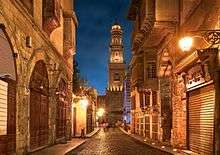Muizz Street


Muizz Street (Egyptian Arabic: شارع المعز Shareʻ El Muizz, full name; Shariʻa al-Muizz li-Deen Illah) (30°02′ 48" N 31°15′ 36"E) in Islamic Cairo, Egypt is one of the oldest streets in Cairo, approximately one kilometer long. A United Nations study found it to have the greatest concentration of medieval architectural treasures in the Islamic world.[1] The street (shariʻa in Arabic) is named for Al-Muʿizz li-Deen Illah, the fourth caliph of the Fatimid dynasty. It stretches from Bab Al-Futuh in the north to Bab Zuweila in the south. Starting in 1997,[2][3] the national government carried out extensive renovations to the historical buildings, modern buildings, paving, and sewerage to turn the street into an "open-air museum". On April 24, 2008, Al-Muizz Street was rededicated as a pedestrian only zone between 8:00 am and 11:00 pm; cargo traffic will be allowed outside of these hours.[4]
The northern part of the street extends from the Al-Hakim Mosque in the north to the Spice Market at Al-Azhar Street and includes the antiques markets section, Al-Aqmar Mosque (one of the few extant Fatimid mosques), the Qalawun complex, and several well preserved medieval mansions and palaces.

The southern part extends from the Ghuriya complex to the Bab Zuweila and includes the magnificent Tent Market in the Gamaliya district.
Historical Buildings of Muizz Street
The area around Muizz Street as well as the main street itself contain many historical buildings ranging from the era of Amr Ibn El As to the Tulunid Period, the Fatimitd, Ayyubid, Mamluk, Ottoman over to the Mohamed Ali Era. Seen from the north of the Muizz Street down to the south the following buildings still exist on the street or near it:
- Mosque of Al Hakim bi Amr Allah (1013)
- Wikala of Qaytbay (1481)
- Mausoleum of Ahmad Al-Qazid (1335)
- Wikala of Qawsum (1330)
- Sabil-Kuttab of Oda Bashi (1673)
- Mosque of Abu Bakr Muzhir (1480)
- Mosque of Sulayman Agha al-Silihdar (1839)
- Bayt al-Suhaymi (1648-1796)
- Sabil Qitas (1630)
- Khanqah of Baybar al-Gashankir (1310)
- Mosque of al-Aqmar (1125)
- Madrasa of Qarasunqur (1300)
- Sabil-Kuttab and Wikala of Dhu'l Fiqar (1673)
- Sabil-Kuttab of Abdel Rahman Katkhuda (1744)
- Mosque of Gamal al-Din Ustadar (1407)
- Musafirkhana Palace (1788)
- Qasr Bashtak (1339)
- Madrasa of Amir Mithqal (1363)
- Mosque of Mahmoud Moharram (1792)
- Sabil of Ismail Pasha (1828)
- Madrasa of Al-Kamil Ayyub (1229)
- Madrasa of Barquq (1386)
- Madrasa of Tatar Al-Higaziya (1348)
- Qa'a of Al-Muwaqqi (1350)
- Madrasa of Al-Nasir Muhammad (1304)
- Complex of Qalawun (1285)
- Maq'ad Of Mamay Al-Sayfi (1496)
- Mosque of Taghri Bardi (1440)
- Sabil-Kuttab of Khusraw Pasha (1535)
- Madrasa of Al-Salih Ayyb (1250)
- Sabila-Kuttab Ali Ibn Hayz (1646)
- Wikala of Gamal Al-Din Al-Dhahabi (1637)
- Sabil-Kuttab of Ahmad Pasha (1864)
- Mosque of Sayyidna Al-Husseyn (1154)
- Wikala of Sulayman Agha Al-Silihdar (1838)
The southern part of Muizz Street area after the intersection with Al-Azhar Street contain the following historical buildings:
- Mosque of Al-Ashraf Barsbay (1425)
- Mosque of Shaykh Ali Al-Mutahhar (1744)
- Mosque of Al-Azhar (970)
- Mosque of Abu Dhahab (1774)
- Madrasa of Sultan Al-Ghuri (1505)
- Mausoleum of Sultan Al-Ghuri (1505)
- Wikala of Al-Ghuri (1505)
- Sabil-Kuttab and Wikala of Qaytbay (1477)
- House of Zaynab Khatun (1713)
- House of Sitt Wasila (1664)
- House of Al-Haraw (1731)
- Mosque of Al-Ayni (1411)
- House of Gamal Al-Din Al-Dhahabi (1634)
- Fakahani Mosque (1735)
- Sabil of Tusun Pasha (1820)
- Mosque of Muayyad (1420)
- Wikala and Sabil of Nafisa Bayda (1796)
- Takiya of Al-Gulshani (1524)
- Zawiya of Farag Ibn Barquq (1408)
- Mosque of Salih Tala'i (1160)
Rehabilitation project
One of the aims of the renovations is to approximate the original appearance of the street. Buildings higher than the level of monuments have been brought down in height and painted an appropriate colour, while the street has been repaved in the original style. 34 monuments along the
References
- Al-Ahram Weekly Online. 4-10 October, 2007.
- Los Angeles Times. 28 Sept. 1997. Once-Splendid Medieval Cairo Crumbles Into Ruins.
- Los Angeles Times. 10 July 1998. Cairo Tries to Reclaim Lost Treasure Amid City’s Trash. Front page feature.
- Reuters. No date. An AOL video accompanied by a Reuters news brief.
See also
| Wikimedia Commons has media related to Muizz Street. |
Coordinates: 30°02′48″N 31°15′36″E / 30.04667°N 31.26000°E